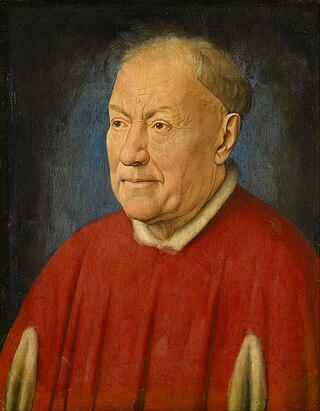Top Qs
Timeline
Chat
Perspective
Portrait of Cardinal Niccolò Albergati
Painting by Jan van Eyck From Wikipedia, the free encyclopedia
Remove ads
The Portrait of Cardinal Niccolò Albergati is a painting by the early Netherlandish painter Jan van Eyck, dating to around 1431 and now in the Kunsthistorisches Museum of Vienna, Austria.

The work shows an elderly cleric who is visibly ageing with deep lines below his eyes. He is shown in near full-frontal profile, dressed in the red robe of a cardinal, lined with luxurious fur.
Remove ads
Description
The cardinal is portrayed from three-quarters, as was usual in Flemish painting since as early as the 1430s. The dark background enhances the figure, who is lit by a bright light source. As is common in van Eyck's work, there is very close attention to detail, aided by his use of successive layers of colours diluted with oil, which allowed him to achieve deep effects of transparency and lucidity.[1]
A preparatory drawing is now in the Staatliche Kunstsammlungen of Dresden, Germany.[2] Comparison with the drawing shows that van Eyck changed several details, such as the depth of the shoulders, the lower curve of the nose, the depth of the mouth and mainly the size of the ear.[citation needed]
Remove ads
Identity of the sitter
Niccolò Albergati was a diplomat working under Pope Martin V. He met van Eyck during a peace congress in Antwerp, who portrayed him in a drawing, which the artist added notes on the colors to execute a later painting portrait. The drawing is now in the Staatliche Kunstsammlungen of Dresden, Germany.
Although Albergati is traditionally identified as the sitter, some modern scholars suggest that Henry Beaufort is more likely to be its subject.[3][4] If the portrait is of Henry Beaufort, it would be the earliest realistic portrait of an Englishman.[4] Other scholars maintain it does not depict a cardinal at all.[5]
Remove ads
See also
External links
 Media related to Portrait of Cardinal Niccolò Albergati by Jan van Eyck at Wikimedia Commons
Media related to Portrait of Cardinal Niccolò Albergati by Jan van Eyck at Wikimedia Commons
References
Sources
Wikiwand - on
Seamless Wikipedia browsing. On steroids.
Remove ads

